您好,登錄后才能下訂單哦!
您好,登錄后才能下訂單哦!
本篇內容介紹了“mysql基礎知識匯總”的有關知識,在實際案例的操作過程中,不少人都會遇到這樣的困境,接下來就讓小編帶領大家學習一下如何處理這些情況吧!希望大家仔細閱讀,能夠學有所成!
select 查詢結果 如: [學號,平均成績:組函數avg(成績)]
from 從哪張表中查找數據 如:[涉及到成績:成績表score]
where 查詢條件 如:[b.課程號='0003' and b.成績>80]
group by 分組 如:[每個學生的平均:按學號分組](oracle,SQL server中出現在select 子句后的非分組函數,必須出現在group by子句后出現),MySQL中可以不用
having 對分組結果指定條件 如:[大于60分]
order by 對查詢結果排序 如:[增序: 成績 ASC / 降序: 成績 DESC];
limit 使用limt子句返回topN(對應這個問題返回的成績前兩名)如:[ limit 2 ==>從0索引開始讀取2個]limit==>從0索引開始 [0,N-1]
① select * from table limit 2,1; //含義是跳過2條取出1條數據,limit后面是從第2條開始讀,讀取1條信息,即讀取第3條數據 ② select * from table limit 2 offset 1; //含義是從第1條(不包括)數據開始取出2條數據,limit后面跟的是2條數據,offset后面是從第1條開始讀取,即讀取第2,3條
組函數: 去重 distinct() 統計總數sum() 計算個數count() 平均數avg() 最大值max() 最小數min()
多表連接: 內連接(省略默認inner) join ...on..左連接left join tableName as b on a.key ==b.key右連接right join 連接union(無重復(過濾去重))和union all(有重復[不過濾去重])
union 并集
union all(有重復)
oracle(SQL server)數據庫
intersect 交集
minus(except) 相減(差集)

oracle
一、數據庫對象: 表(table) 視圖(view) 序列(sequence) 索引(index) 同義詞(synonym)
1. 視圖: 存儲起來的 select 語句
create view emp_vw as select employee_id, last_name, salary from employees where department_id = 90; select * from emp_vw;
可以對簡單視圖進行 DML 操作
update emp_vw set last_name = 'HelloKitty' where employee_id = 100; select * from employees where employee_id = 100;
1). 復雜視圖
create view emp_vw2 as select department_id, avg(salary) avg_sal from employees group by department_id; select * from emp_vw2;
復雜視圖不能進行 DML 操作
update emp_vw2 set avg_sal = 10000 where department_id = 100;
2. 序列:用于生成一組有規律的數值。(通常用于為主鍵設置值)
create sequence emp_seq1 start with 1 increment by 1 maxvalue 10000 minvalue 1 cycle nocache; select emp_seq1.currval from dual; select emp_seq1.nextval from dual;
問題:裂縫 . 原因:
當多個表共用同一個序列時。
rollback
發生異常
create table emp1( id number(10), name varchar2(30) ); insert into emp1 values(emp_seq1.nextval, '張三'); select * from emp1;
3. 索引:提高查詢效率
自動創建:Oracle 會為具有唯一約束(唯一約束,主鍵約束)的列,自動創建索引
create table emp2( id number(10) primary key, name varchar2(30) )
手動創建
create index emp_idx on emp2(name); create index emp_idx2 on emp2(id, name);
4. 同義詞
create synonym d1 for departments; select * from d1;
5. 表:
DDL :數據定義語言 create table .../ drop table ... / rename ... to..../ truncate table.../alter table ...
DML : 數據操縱語言
insert into ... values ... update ... set ... where ... delete from ... where ...
【重要】
select ... 組函數(MIN()/MAX()/SUM()/AVG()/COUNT())
from ...join ... on ... 左外連接:left join ... on ... 右外連接: right join ... on ...
where ...
group by ... (oracle,SQL server中出現在select 子句后的非分組函數,必須出現在 group by子句后)
having ... 用于過濾 組函數
order by ... asc 升序, desc 降序
limit (0,4) 限制N條數據 如: topN數據
union 并集
union all(有重復)
intersect 交集
minus 相減
DCL : 數據控制語言 commit : 提交 / rollback : 回滾 / 授權grant...to... /revoke

索引



何時創建索引:

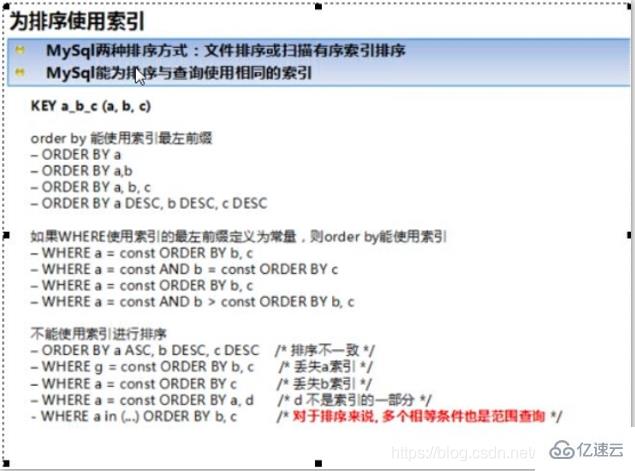

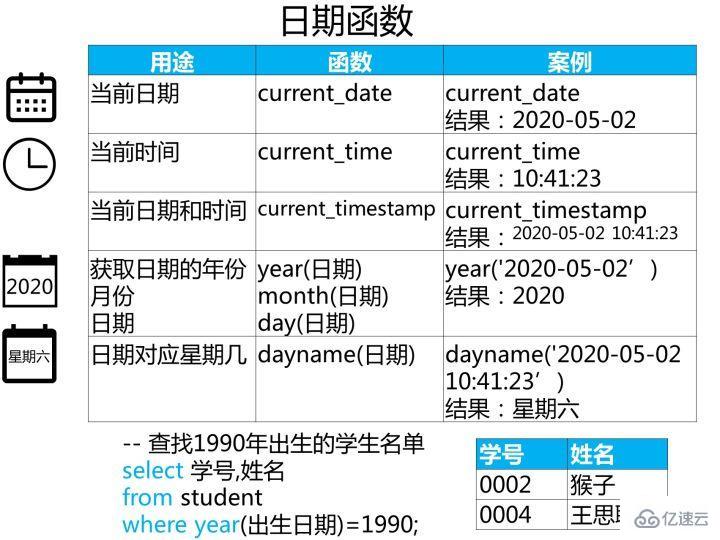
一、
select employee_id, last_name, salary, department_id from employees where department_id in (70, 80) --> 70:1 80:34
union 并集
union all(有重復部分)
intersect 交集
minus 相減
select employee_id, last_name, salary, department_id from employees where department_id in (80, 90) --> 90:4 80:34
問題:查詢工資大于149號員工工資的員工的信息
select * from employees where salary > ( select salary from employees where employee_id = 149 )
問題:查詢與141號或174號員工的manager_id和department_id相同的其他員工的
employee_id, manager_id, department_id select employee_id, manager_id, department_id from employees where manager_id in ( select manager_id from employees where employee_id in(141, 174) ) and department_id in ( select department_id from employees where employee_id in(141, 174) ) and employee_id not in (141, 174); select employee_id, manager_id, department_id from employees where (manager_id, department_id) in ( select manager_id, department_id from employees where employee_id in (141, 174) ) and employee_id not in(141, 174);
1. from 子句中使用子查詢
select max(avg(salary)) from employees group by department_id; select max(avg_sal) from ( select avg(salary) avg_sal from employees group by department_id ) e
問題:返回比本部門平均工資高的員工的last_name, department_id, salary及平均工資
select last_name, department_id, salary, (select avg(salary) from employees where department_id = e1.department_id) from employees e1 where salary > ( select avg(salary) from employees e2 where e1.department_id = e2.department_id ) select last_name, e1.department_id, salary, avg_sal from employees e1, ( select department_id, avg(salary) avg_sal from employees group by department_id ) e2 where e1.department_id = e2.department_id and e1.salary > e2.avg_sal;
case...when ... then... when ... then ... else ... end
查詢:若部門為10 查看工資的 1.1 倍,部門號為 20 工資的1.2倍,其余 1.3 倍
select employee_id, last_name, salary, case department_id when 10 then salary * 1.1 when 20 then salary * 1.2 else salary * 1.3 end "new_salary" from employees; select employee_id, last_name, salary, decode(department_id, 10, salary * 1.1, 20, salary * 1.2, salary * 1.3) "new_salary" from employees;
問題:顯式員工的employee_id,last_name和location。其中,若員工department_id與location_id為1800的department_id相同,則location為’Canada’,其余則為’USA’。
select employee_id, last_name, case department_id when ( select department_id from departments where location_id = 1800 ) then 'Canada' else 'USA' end "location" from employees;
問題:查詢員工的employee_id,last_name,要求按照員工的department_name排序
select employee_id, last_name from employees e1 order by ( select department_name from departments d1 where e1.department_id = d1.department_id )
SQL 優化:能使用 EXISTS 就不要使用 IN
問題:查詢公司管理者的employee_id,last_name,job_id,department_id信息
select employee_id, last_name, job_id, department_id from employees where employee_id in ( select manager_id from employees ) select employee_id, last_name, job_id, department_id from employees e1 where exists ( select 'x' from employees e2 where e1.employee_id = e2.manager_id )
問題:查詢departments表中,不存在于employees表中的部門的department_id和department_name
select department_id, department_name from departments d1 where not exists ( select 'x' from employees e1 where e1.department_id = d1.department_id )
更改 108 員工的信息: 使其工資變為所在部門中的最高工資, job 變為公司中平均工資最低的 job
update employees e1 set salary = ( select max(salary) from employees e2 where e1.department_id = e2.department_id ), job_id = ( select job_id from employees group by job_id having avg(salary) = ( select min(avg(salary)) from employees group by job_id ) ) where employee_id = 108;
56. 刪除 108 號員工所在部門中工資最低的那個員工.
delete from employees e1 where salary = ( select min(salary) from employees where department_id = ( select department_id from employees where employee_id = 108 ) ) select * from employees where employee_id = 108; select * from employees where department_id = 100 order by salary; rollback;
已知有如下4張表:
學生表:student(學號,學生姓名,出生年月,性別)
成績表:score(學號,課程號,成績)
課程表:course(課程號,課程名稱,教師號)
教師表:teacher(教師號,教師姓名)
根據以上信息按照下面要求寫出對應的SQL語句。
ps:這些題考察SQL的編寫能力,對于這類型的題目,需要你先把4張表之間的關聯關系搞清楚了,最好的辦法是自己在草稿紙上畫出關聯圖,然后再編寫對應的SQL語句就比較容易了。下圖是我畫的這4張表的關系圖,可以看出它們之間是通過哪些外鍵關聯起來的:

一、創建數據庫和表
為了演示題目的運行過程,我們先按下面語句在客戶端navicat中創建數據庫和表。
(如何你還不懂什么是數據庫,什么是客戶端navicat,可以先學習這個:

1.創建表
1)創建學生表(student)
按下圖在客戶端navicat里創建學生表

學生表的“學號”列設置為主鍵約束,下圖是每一列設置的數據類型和約束

創建完表,點擊“保存”
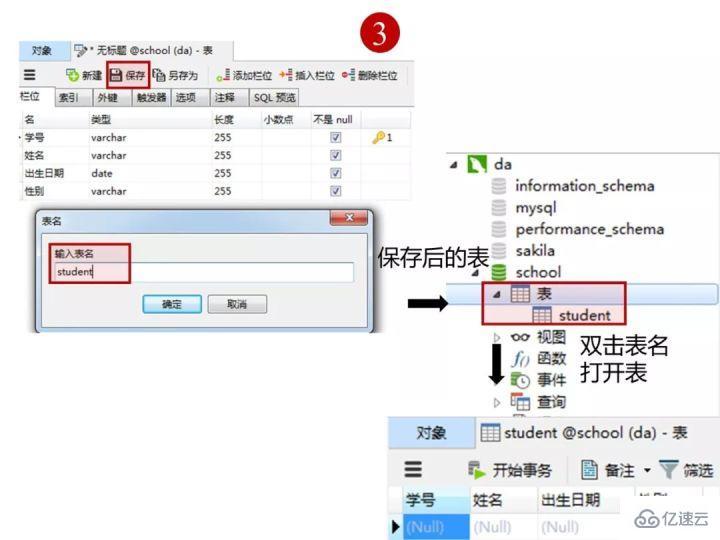
2)創建成績表(score)
同樣的步驟,創建"成績表“。“課程表的“學號”和“課程號”一起設置為主鍵約束(聯合主鍵),“成績”這一列設置為數值類型(float,浮點數值)
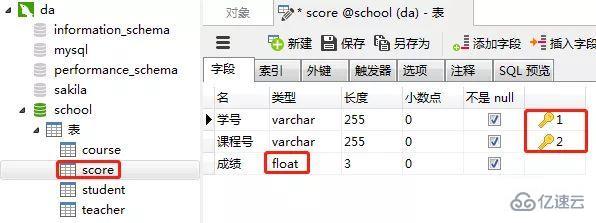
3)創建課程表(course)
課程表的“課程號”設置為主鍵約束

4)教師表(teacher)
教師表的“教師號”列設置為主鍵約束,
教師姓名這一列設置約束為“null”(紅框的地方不勾選),表示這一列允許包含空值(null)

2.向表中添加數據

1)向學生表里添加數據
添加數據的sql
insert into student(學號,姓名,出生日期,性別)
values('0001' , '猴子' , '1989-01-01' , '男');
insert into student(學號,姓名,出生日期,性別)
values('0002' , '猴子' , '1990-12-21' , '女');
insert into student(學號,姓名,出生日期,性別)
values('0003' , '馬云' , '1991-12-21' , '男');
insert into student(學號,姓名,出生日期,性別)
values('0004' , '王思聰' , '1990-05-20' , '男');在客戶端navicat里的操作


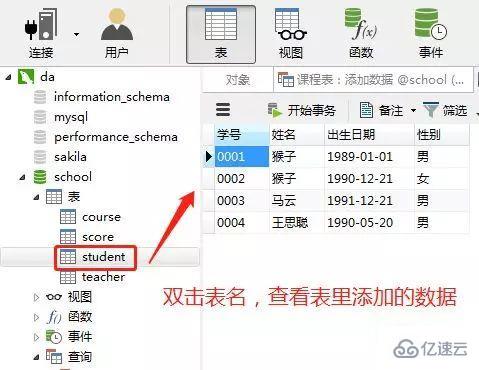
2)成績表(score)
添加數據的sql
insert into score(學號,課程號,成績)
values('0001' , '0001' , 80);
insert into score(學號,課程號,成績)
values('0001' , '0002' , 90);
insert into score(學號,課程號,成績)
values('0001' , '0003' , 99);
insert into score(學號,課程號,成績)
values('0002' , '0002' , 60);
insert into score(學號,課程號,成績)
values('0002' , '0003' , 80);
insert into score(學號,課程號,成績)
values('0003' , '0001' , 80);
insert into score(學號,課程號,成績)
values('0003' , '0002' , 80);
insert into score(學號,課程號,成績)
values('0003' , '0003' , 80);客戶端navicat里的操作

3)課程表
添加數據的sql
insert into course(課程號,課程名稱,教師號)
values('0001' , '語文' , '0002');
insert into course(課程號,課程名稱,教師號)
values('0002' , '數學' , '0001');
insert into course(課程號,課程名稱,教師號)
values('0003' , '英語' , '0003');客戶端navicat里的操作

4)教師表里添加數據
添加數據的sql
-- 教師表:添加數據
insert into teacher(教師號,教師姓名)
values('0001' , '孟扎扎');
insert into teacher(教師號,教師姓名)
values('0002' , '馬化騰');
-- 這里的教師姓名是空值(null)
insert into teacher(教師號,教師姓名)
values('0003' , null);
-- 這里的教師姓名是空字符串('')
insert into teacher(教師號,教師姓名)
values('0004' , '');客戶端navicat里操作
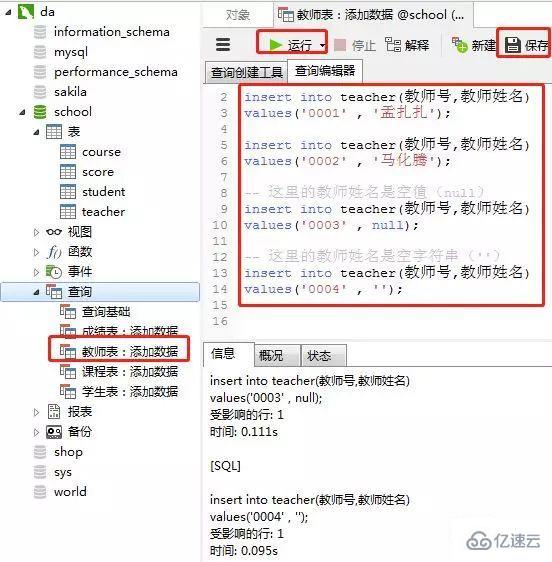
添加結果
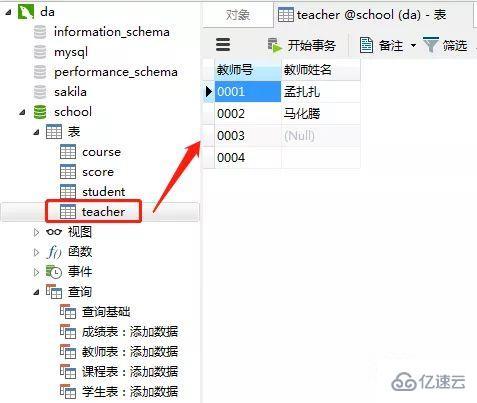
為了方便學習,我將50道面試題進行了分類
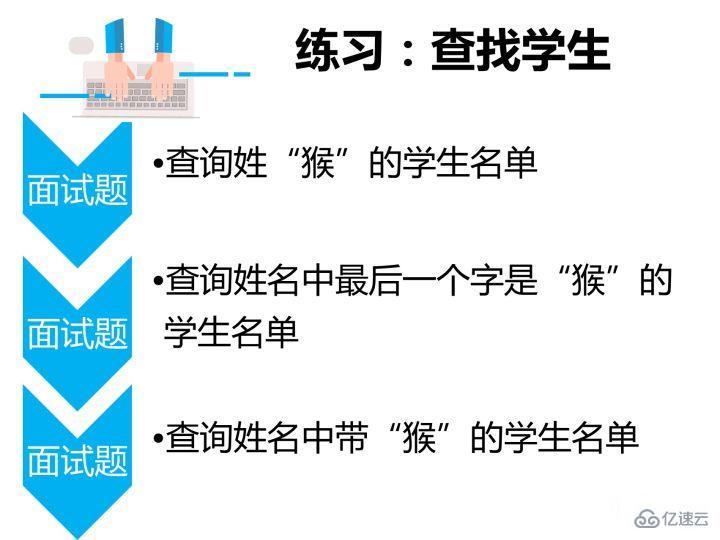
查詢姓“猴”的學生名單
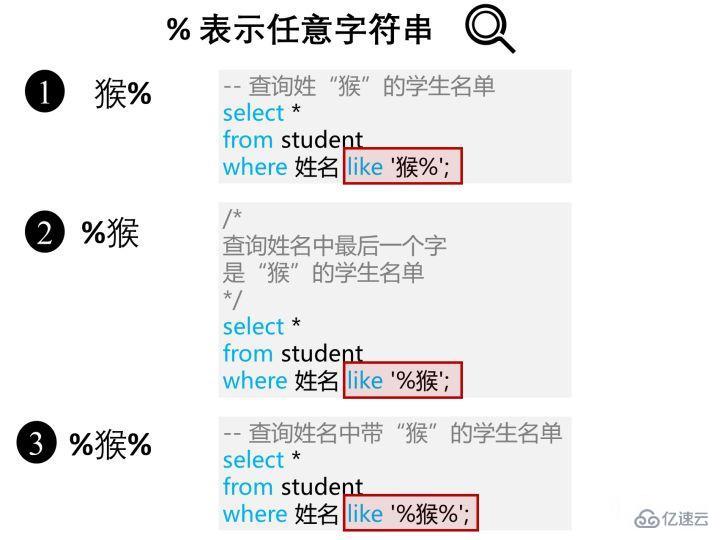
查詢姓“孟”老師的個數
select count(教師號) from teacher where 教師姓名 like '孟%';
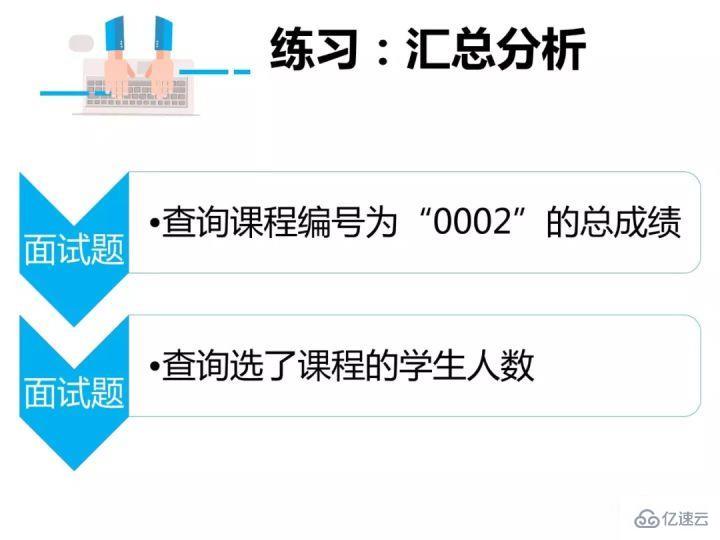
面試題:查詢課程編號為“0002”的總成績
/* 分析思路 select 查詢結果 [總成績:匯總函數sum] from 從哪張表中查找數據[成績表score] where 查詢條件 [課程號是0002] */ select sum(成績) from score where 課程號 = '0002';
查詢選了課程的學生人數
/* 這個題目翻譯成大白話就是:查詢有多少人選了課程 select 學號,成績表里學號有重復值需要去掉 from 從課程表查找score; */ select count(distinct 學號) as 學生人數 from score;
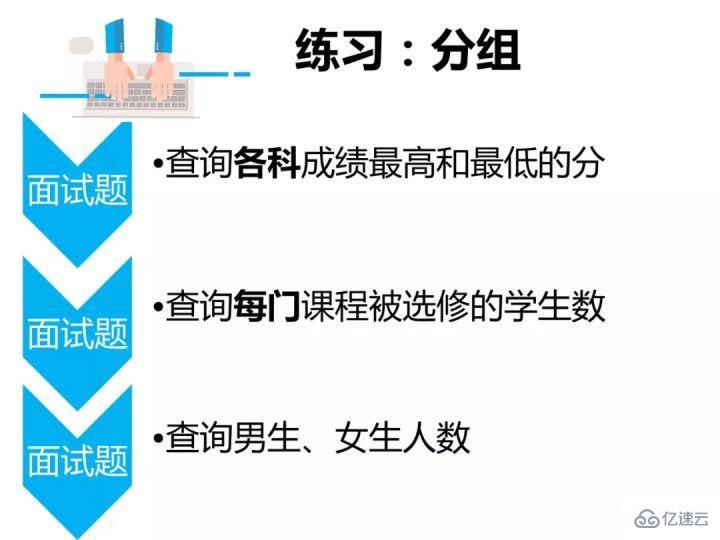
查詢各科成績最高和最低的分, 以如下的形式顯示:課程號,最高分,最低分
/* 分析思路 select 查詢結果 [課程ID:是課程號的別名,最高分:max(成績) ,最低分:min(成績)] from 從哪張表中查找數據 [成績表score] where 查詢條件 [沒有] group by 分組 [各科成績:也就是每門課程的成績,需要按課程號分組]; */ select 課程號,max(成績) as 最高分,min(成績) as 最低分 from score group by 課程號;
查詢每門課程被選修的學生數
/* 分析思路 select 查詢結果 [課程號,選修該課程的學生數:匯總函數count] from 從哪張表中查找數據 [成績表score] where 查詢條件 [沒有] group by 分組 [每門課程:按課程號分組]; */ select 課程號, count(學號) from score group by 課程號;
查詢男生、女生人數
/* 分析思路 select 查詢結果 [性別,對應性別的人數:匯總函數count] from 從哪張表中查找數據 [性別在學生表中,所以查找的是學生表student] where 查詢條件 [沒有] group by 分組 [男生、女生人數:按性別分組] having 對分組結果指定條件 [沒有] order by 對查詢結果排序[沒有]; */ select 性別,count(*) from student group by 性別;
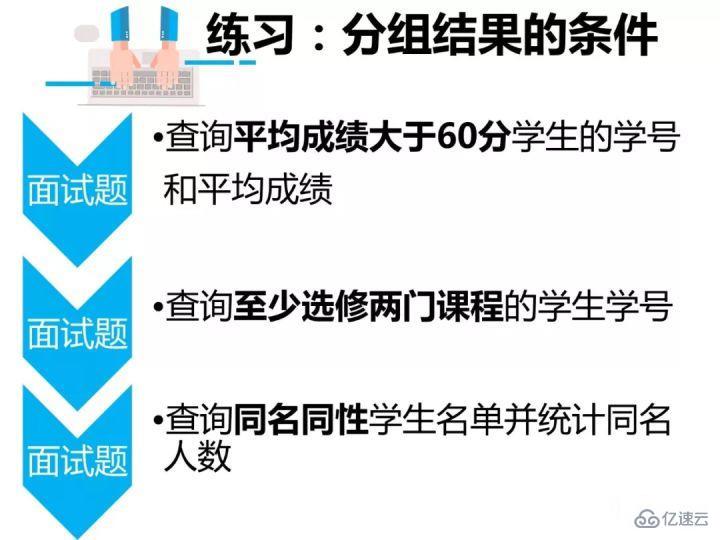
查詢平均成績大于60分學生的學號和平均成績
/* 題目翻譯成大白話: 平均成績:展開來說就是計算每個學生的平均成績 這里涉及到“每個”就是要分組了 平均成績大于60分,就是對分組結果指定條件 分析思路 select 查詢結果 [學號,平均成績:匯總函數avg(成績)] from 從哪張表中查找數據 [成績在成績表中,所以查找的是成績表score] where 查詢條件 [沒有] group by 分組 [平均成績:先按學號分組,再計算平均成績] having 對分組結果指定條件 [平均成績大于60分] */ select 學號, avg(成績) from score group by 學號 having avg(成績)>60;
查詢至少選修兩門課程的學生學號
/* 翻譯成大白話: 第1步,需要先計算出每個學生選修的課程數據,需要按學號分組 第2步,至少選修兩門課程:也就是每個學生選修課程數目>=2,對分組結果指定條件 分析思路 select 查詢結果 [學號,每個學生選修課程數目:匯總函數count] from 從哪張表中查找數據 [課程的學生學號:課程表score] where 查詢條件 [至少選修兩門課程:需要先計算出每個學生選修了多少門課,需要用分組,所以這里沒有where子句] group by 分組 [每個學生選修課程數目:按課程號分組,然后用匯總函數count計算出選修了多少門課] having 對分組結果指定條件 [至少選修兩門課程:每個學生選修課程數目>=2] */ select 學號, count(課程號) as 選修課程數目 from score group by 學號 having count(課程號)>=2;
查詢同名同性學生名單并統計同名人數
/* 翻譯成大白話,問題解析: 1)查找出姓名相同的學生有誰,每個姓名相同學生的人數 查詢結果:姓名,人數 條件:怎么算姓名相同?按姓名分組后人數大于等于2,因為同名的人數大于等于2 分析思路 select 查詢結果 [姓名,人數:匯總函數count(*)] from 從哪張表中查找數據 [學生表student] where 查詢條件 [沒有] group by 分組 [姓名相同:按姓名分組] having 對分組結果指定條件 [姓名相同:count(*)>=2] order by 對查詢結果排序[沒有]; */ select 姓名,count(*) as 人數 from student group by 姓名 having count(*)>=2;
查詢不及格的課程并按課程號從大到小排列
/* 分析思路 select 查詢結果 [課程號] from 從哪張表中查找數據 [成績表score] where 查詢條件 [不及格:成績 <60] group by 分組 [沒有] having 對分組結果指定條件 [沒有] order by 對查詢結果排序[課程號從大到小排列:降序desc]; */ select 課程號 from score where 成績<60 order by 課程號 desc;
查詢每門課程的平均成績,結果按平均成績升序排序,平均成績相同時,按課程號降序排列
/* 分析思路 select 查詢結果 [課程號,平均成績:匯總函數avg(成績)] from 從哪張表中查找數據 [成績表score] where 查詢條件 [沒有] group by 分組 [每門課程:按課程號分組] having 對分組結果指定條件 [沒有] order by 對查詢結果排序[按平均成績升序排序:asc,平均成績相同時,按課程號降序排列:desc]; */ select 課程號, avg(成績) as 平均成績 from score group by 課程號 order by 平均成績 asc,課程號 desc;
檢索課程編號為“0004”且分數小于60的學生學號,結果按按分數降序排列
/* 分析思路 select 查詢結果 [] from 從哪張表中查找數據 [成績表score] where 查詢條件 [課程編號為“04”且分數小于60] group by 分組 [沒有] having 對分組結果指定條件 [] order by 對查詢結果排序[查詢結果按按分數降序排列]; */ select 學號 from score where 課程號='04' and 成績 <60 order by 成績 desc;
統計每門課程的學生選修人數(超過2人的課程才統計)
要求輸出課程號和選修人數,查詢結果按人數降序排序,若人數相同,按課程號升序排序
/* 分析思路 select 查詢結果 [要求輸出課程號和選修人數] from 從哪張表中查找數據 [] where 查詢條件 [] group by 分組 [每門課程:按課程號分組] having 對分組結果指定條件 [學生選修人數(超過2人的課程才統計):每門課程學生人數>2] order by 對查詢結果排序[查詢結果按人數降序排序,若人數相同,按課程號升序排序]; */ select 課程號, count(學號) as '選修人數' from score group by 課程號 having count(學號)>2 order by count(學號) desc,課程號 asc;
查詢兩門以上不及格課程的同學的學號及其平均成績
/* 分析思路 先分解題目: 1)[兩門以上][不及格課程]限制條件 2)[同學的學號及其平均成績],也就是每個學生的平均成績,顯示學號,平均成績 分析過程: 第1步:得到每個學生的平均成績,顯示學號,平均成績 第2步:再加上限制條件: 1)不及格課程 2)兩門以上[不及格課程]:課程數目>2 */ /* 第1步:得到每個學生的平均成績,顯示學號,平均成績 select 查詢結果 [學號,平均成績:匯總函數avg(成績)] from 從哪張表中查找數據 [涉及到成績:成績表score] where 查詢條件 [沒有] group by 分組 [每個學生的平均:按學號分組] having 對分組結果指定條件 [沒有] order by 對查詢結果排序[沒有]; */ select 學號, avg(成績) as 平均成績 from score group by 學號; /* 第2步:再加上限制條件: 1)不及格課程 2)兩門以上[不及格課程] select 查詢結果 [學號,平均成績:匯總函數avg(成績)] from 從哪張表中查找數據 [涉及到成績:成績表score] where 查詢條件 [限制條件:不及格課程,平均成績<60] group by 分組 [每個學生的平均:按學號分組] having 對分組結果指定條件 [限制條件:課程數目>2,匯總函數count(課程號)>2] order by 對查詢結果排序[沒有]; */ select 學號, avg(成績) as 平均成績 from score where 成績 <60 group by 學號 having count(課程號)>=2;
如果上面題目不會做,可以復習這部分涉及到的sql知識:
查詢所有課程成績小于60分學生的學號、姓名
【知識點】子查詢
1.翻譯成大白話
1)查詢結果:學生學號,姓名
2)查詢條件:所有課程成績 < 60 的學生,需要從成績表里查找,用到子查詢
第1步,寫子查詢(所有課程成績 < 60 的學生)
select 查詢結果[學號]
from 從哪張表中查找數據[成績表:score]
where 查詢條件[成績 < 60]
group by 分組[沒有]
having 對分組結果指定條件[沒有]
order by 對查詢結果排序[沒有]
limit 從查詢結果中取出指定行[沒有];
select 學號 from score where 成績 < 60;
第2步,查詢結果:學生學號,姓名,條件是前面1步查到的學號
select 查詢結果[學號,姓名]
from 從哪張表中查找數據[學生表:student]
where 查詢條件[用到運算符in]
group by 分組[沒有]
having 對分組結果指定條件[沒有]
order by 對查詢結果排序[沒有]
limit 從查詢結果中取出指定行[沒有];
select 學號,姓名 from student where 學號 in ( select 學號 from score where 成績 < 60 );
查詢沒有學全所有課的學生的學號、姓名|
/* 查找出學號,條件:沒有學全所有課,也就是該學生選修的課程數 < 總的課程數 【考察知識點】in,子查詢 */ select 學號,姓名 from student where 學號 in( select 學號 from score group by 學號 having count(課程號) < (select count(課程號) from course) );
查詢出只選修了兩門課程的全部學生的學號和姓名|
select 學號,姓名 from student where 學號 in( select 學號 from score group by 學號 having count(課程號)=2 );
1990年出生的學生名單

/* 查找1990年出生的學生名單 學生表中出生日期列的類型是datetime */ select 學號,姓名 from student where year(出生日期)=1990;
查詢各科成績前兩名的記錄
這類問題其實就是常見的:分組取每組最大值、最小值,每組最大的N條(top N)記錄。
工作中會經常遇到這樣的業務問題:
如何找到每個類別下用戶最喜歡的產品是哪個?
如果找到每個類別下用戶點擊最多的5個商品是什么?
這類問題其實就是常見的:分組取每組最大值、最小值,每組最大的N條(top N)記錄。
面對該類問題,如何解決呢?
下面我們通過成績表的例子來給出答案。
成績表是學生的成績,里面有學號(學生的學號),課程號(學生選修課程的課程號),成績(學生選修該課程取得的成績)

分組取每組最大值
案例:按課程號分組取成績最大值所在行的數據
我們可以使用分組(group by)和匯總函數得到每個組里的一個值(最大值,最小值,平均值等)。但是無法得到成績最大值所在行的數據。
select 課程號,max(成績) as 最大成績 from score group by 課程號;

我們可以使用關聯子查詢來實現:
select * from score as a where 成績 = ( select max(成績) from score as b where b.課程號 = a.課程號);

上面查詢結果課程號“0001”有2行數據,是因為最大成績80有2個
分組取每組最小值
案例:按課程號分組取成績最小值所在行的數據
同樣的使用關聯子查詢來實現
select * from score as a where 成績 = ( select min(成績) from score as b where b.課程號 = a.課程號);

每組最大的N條記錄
案例:查詢各科成績前兩名的記錄
第1步,查出有哪些組
我們可以按課程號分組,查詢出有哪些組,對應這個問題里就是有哪些課程號
select 課程號,max(成績) as 最大成績 from score group by 課程號;

第2步:先使用order by子句按成績降序排序(desc),然后使用limt子句返回topN(對應這個問題返回的成績前兩名)
-- 課程號'0001' 這一組里成績前2名 select * from score where 課程號 = '0001' order by 成績 desc limit 2;
同樣的,可以寫出其他組的(其他課程號)取出成績前2名的sql
第3步,使用union all 將每組選出的數據合并到一起
-- 左右滑動可以可拿到全部sql (select * from score where 課程號 = '0001' order by 成績 desc limit 2) union all (select * from score where 課程號 = '0002' order by 成績 desc limit 2) union all (select * from score where 課程號 = '0003' order by 成績 desc limit 2);

前面我們使用order by子句按某個列降序排序(desc)得到的是每組最大的N個記錄。如果想要達到每組最小的N個記錄,將order by子句按某個列升序排序(asc)即可。
求topN的問題還可以使用自定義變量來實現,這個在后續再介紹。
如果對多表合并還不了解的,可以看下我講過的《從零學會SQL》的“多表查詢”。
總結
常見面試題:分組取每組最大值、最小值,每組最大的N條(top N)記錄。

查詢所有學生的學號、姓名、選課數、總成績
selecta.學號,a.姓名,count(b.課程號) as 選課數,sum(b.成績) as 總成績 from student as a left join score as b on a.學號 = b.學號 group by a.學號;
查詢平均成績大于85的所有學生的學號、姓名和平均成績
select a.學號,a.姓名, avg(b.成績) as 平均成績 from student as a left join score as b on a.學號 = b.學號 group by a.學號 having avg(b.成績)>85;
查詢學生的選課情況:學號,姓名,課程號,課程名稱
select a.學號, a.姓名, c.課程號,c.課程名稱 from student a inner join score b on a.學號=b.學號 inner join course c on b.課程號=c.課程號;
查詢出每門課程的及格人數和不及格人數
-- 考察case表達式 select 課程號, sum(case when 成績>=60 then 1 else 0 end) as 及格人數, sum(case when 成績 < 60 then 1 else 0 end) as 不及格人數 from score group by 課程號;
使用分段[100-85],[85-70],[70-60],[<60]來統計各科成績,分別統計:各分數段人數,課程號和課程名稱
-- 考察case表達式 select a.課程號,b.課程名稱, sum(case when 成績 between 85 and 100 then 1 else 0 end) as '[100-85]', sum(case when 成績 >=70 and 成績<85 then 1 else 0 end) as '[85-70]', sum(case when 成績>=60 and 成績<70 then 1 else 0 end) as '[70-60]', sum(case when 成績<60 then 1 else 0 end) as '[<60]' from score as a right join course as b on a.課程號=b.課程號 group by a.課程號,b.課程名稱;
查詢課程編號為0003且課程成績在80分以上的學生的學號和姓名|
select a.學號,a.姓名 from student as a inner join score as b on a.學號=b.學號 where b.課程號='0003' and b.成績>80;
下面是學生的成績表(表名score,列名:學號、課程號、成績)

使用sql實現將該表行轉列為下面的表結構

【面試題】下面是學生的成績表(表名score,列名:學號、課程號、成績)

使用sql實現將該表行轉列為下面的表結構

【解答】
第1步,使用常量列輸出目標表的結構
可以看到查詢結果已經和目標表非常接近了
select 學號,'課程號0001','課程號0002','課程號0003' from score;

第2步,使用case表達式,替換常量列為對應的成績
select 學號, (case 課程號 when '0001' then 成績 else 0 end) as '課程號0001', (case 課程號 when '0002' then 成績 else 0 end) as '課程號0002', (case 課程號 when '0003' then 成績 else 0 end) as '課程號0003' from score;

在這個查詢結果中,每一行表示了某個學生某一門課程的成績。比如第一行是'學號0001'選修'課程號00001'的成績,而其他兩列的'課程號0002'和'課程號0003'成績為0。
每個學生選修某門課程的成績在下圖的每個方塊內。我們可以通過分組,取出每門課程的成績。

第3關,分組
分組,并使用最大值函數max取出上圖每個方塊里的最大值
select 學號, max(case 課程號 when '0001' then 成績 else 0 end) as '課程號0001', max(case 課程號 when '0002' then 成績 else 0 end) as '課程號0002', max(case 課程號 when '0003' then 成績 else 0 end) as '課程號0003' from score group by 學號;
這樣我們就得到了目標表(行列互換)

“mysql基礎知識匯總”的內容就介紹到這里了,感謝大家的閱讀。如果想了解更多行業相關的知識可以關注億速云網站,小編將為大家輸出更多高質量的實用文章!
免責聲明:本站發布的內容(圖片、視頻和文字)以原創、轉載和分享為主,文章觀點不代表本網站立場,如果涉及侵權請聯系站長郵箱:is@yisu.com進行舉報,并提供相關證據,一經查實,將立刻刪除涉嫌侵權內容。